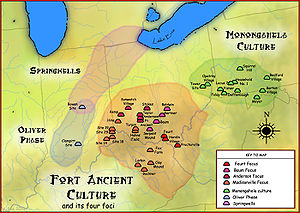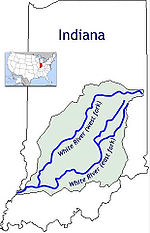- Oliver Phase
-
The Oliver Phase is the name for a Late Woodland Native American culture that flourished from 1200 and 1450 CE along the east and west forks of the White River in central and southern Indiana.[1] The Oliver Phase is of the Western Basin Tradition which includes the Springwells Phase, the Younge Phase, and the Riviere au Vase Phase.[2] Oliver people were village dwelling farmers with a heavy reliance on maize,[1] very similar to other Late Woodland peoples in the area the Oneota, Fort Ancient, and Monongahela cultures. The name was originally coined by archaeologist James B. Griffin in 1946 to describe a Late Woodland ceramic complex centered in Hamilton and Marion counties in the valley of the West Fork of the White River first extensively studied at the Bowen site.[3]
Contents
Archaeological record
Villages
Their villages, like their neighbors to the southeast the Fort Ancient culture, were usually circular with wooden palisades, and earthen moats found in the Whittlesey Tradition,[4] although they also lived in smaller farmsteads. Although their sites began in central Indiana, over the years they spread to the southeast.[1] The Clampitt Site (12-Lr-329) was excavated in the summer of 1992.[3] It was a settlement in the East Fork White River Valley, occupied by a late prehistoric to protohistoric agricultural population. Most of the settlements in this area were nucleated villages and hunting camps. The larger villages such as Clampitt (in Lawrence County) and Bowen Sites(in Marion County) were roughly one to two acres in size. They intentionally located their sites on alluvial floodplains, usually a kilometer or so from tributary streams of the river, to take advantage of the richer soils there.[3] The Bowen Site (12 MA 61) was located on the West Fork of the White River, a little to the northeast of Indianapolis, and was occupied at least twice by two similar but slightly different cultures.[5]
Pottery
Pottery styles were originally used to determine the existence of the Oliver Phase. Most items were globular, grit-tempered jars that showed a mixture of traits associated with both the Great Lakes Late Woodland Oneota and Fort Ancient cultures.[3]
See also
- Fort Ancient culture
- Caborn-Welborn culture
- Monongahela culture
- Oneota
References
- ^ a b c "Geophysical Methods and the Archaeology of Late Prehistoric Central Indiana". http://www.ipfw.edu/archsurv/research_program.html. Retrieved 2010-02-25.
- ^ Ohio Historic Preservation Office and the U.S.Department of the Interior’s Historic Preservation Fund. Copyright © 2007 Ohio Historical Society, Inc. All rights reserved. [1] (Ret:11/22/09)
- ^ a b c d "Introduction(Clampitt Site)". http://www.gbl.indiana.edu/abstracts/clampitt/intro.html. Retrieved 2010-02-25.
- ^ Whittlesey Tradition Late Prehistoric Farmers and Villagers, An Archaeological History of Northeast Ohio, Before the Western Reserve: An Archaeological History of Northeast Ohio, Brian G. Redmond, Ph.D., Curator of Archaeology [2] (ret. July 22, 2010)
- ^ "HUMAN DENTITION FROM THE BOWEN SITE, 12 MA 61". http://www.gbl.indiana.edu/abstracts/92/bush_92.html. Retrieved 2010-02-25.
External links
 Late Woodland cultures
Late Woodland culturesMound builder (people) · List of archaeological periods (North America) Sites Baytown Site · Beattie Park Mound Group · Book Site · Bowen Site (12 MA 61) · Brinsfield I Site · Brokaw Site · Clampitt Site (12-LR-329) · Fisher Site · Hoye Site · Little Maquoketa River Mounds State Preserve · Memorial Park Site · Mott Mounds · Nottingham Site · Ormond Mound · Sommerheim Park · Troyville Earthworks · University of Tennessee Agriculture Farm Mound ·Cultures Alachua culture · Baytown culture · Clemson Island culture · Coles Creek culture · Manahoac · Monongahela culture · Oliver Phase · Plum Bayou culture · Springwells Phase · Troyville culture · Weeden Island culture ·Related topics · Steuben point · Belle Glade culture · Extreme weather events of 535–536 · Fort Ancient culture · Mississippian culture · Oneota · St. Johns culture · Categories:- Woodland period of North America
- Archaeological sites in Indiana
- Archaeological cultures of North America
- Native Americans in Indiana
Wikimedia Foundation. 2010.



